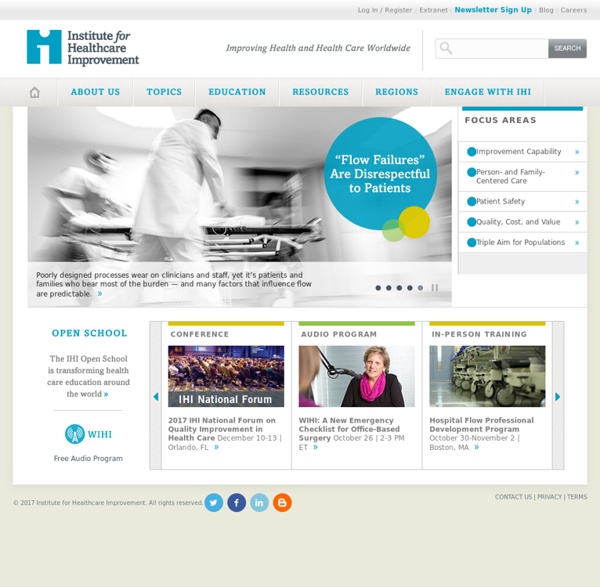



Welcome to Irish Medication Safety Network Biogeochemistry using Melastoma M... preview & related info Abstract This research is about biogeochemistry which investigates the relationship of heavy metals concentration contained within plants versus soil samples in the selected area of Sokor, Kelantan. The identified lithology of the study area is argillaceous and calcareous units and the geological structures of folding which contribute to the current bed dipping and hydrothermal alteration through joint infilling has indicated an ore deposit region. Four sets of soil and plant samples had been collected and characterized through X-Ray Diffraction, X-Ray Fluorescence and Inductively Coupled Plasma Mass Spectrometry respectively. The main composition of soil is clay minerals, kaolinite, dickite and pyrophyliite which can indicate argillic alteration and possible supergene enrichment for ore deposition.
Aligning Forces for Quality A September 1 study in the New England Journal of Medicine by the AF4Q Alliance in Cleveland found that the quality of diabetes care, across insurance types including Medicaid and uninsured patients, was improved by the meaningful use of electronic health records (EHRs). “We were not surprised by these results,” said Randall D. Cebul, MD, director of Better Health Greater Cleveland and the study’s lead author, “but they were influenced by several factors, including our public reporting on agreed-upon standards of care and the willingness of our clinical partners to share their EHR-based best practices while simultaneously competing on their execution.” The research involved more than 500 primary care physicians in 46 practices that are partners in Better Health Greater Cleveland.
UMC | Uppsala Monitoring Centre Masspro At some point in everyone's life, the quality of care will be a matter not just of public concern, but of personal interest. Masspro is one of the leading healthcare assessment and quality improvement companies in the United States. We are also the federally endorsed Quality Improvement Organization for Massachusetts. Dedicated to improving patient care for better patient outcomes, we partner with our clients and the healthcare community to achieve improvements in the delivery of care using validated clinical evidence and data. With our assistance, providers can easily adapt to the ever-changing systems of healthcare and ensure that patients are assured the highest quality of care possible at an optimal cost. Masspro's Services Lead to Clear Knowledge Masspro’s quality improvement services lead to clear knowledge about where improvements can be made across all sectors of the healthcare delivery system. Effective Clinical Measures Safe Clinical Care Efficient Patient Care
EudraLex - Volume 1 - Pharmaceutical legislation for medicinal products for human use | Public Health 2015 marks the 50th anniversary of pharmaceutical legislation in the EU, which began with the adoption of Directive 65/65 in 1965. Today the EU legal framework for medicinal products for human use guarantees high standards of quality and safety of medicinal products, while promoting the good functioning of the internal market with measures that encourage innovation and competiveness. Directives Regulations Non-Legislative acts Miscellaneous Directives Regulations Non-legislative acts Miscellaneous
Improving Value in Health Care ... Dr. Semmelweis’ Biography at Semmelweis Society International Dr. Ignaz Semmelweis Ignaz Philipp Semmelweis (July 1, 1818 – August 13, 1865), also Ignác Semmelweis (born Semmelweis Ignác Fülöp), was a Hungarian physician called the “saviour of mothers” who discovered, by 1847, that the incidence of puerperal fever, also known as childbed fever could be drastically cut by use of hand washing standards in obstetrical clinics. While employed as assistant to the professor of the maternity clinic at the Vienna General Hospital in Austria in 1847, Semmelweis introduced hand washing with chlorinated lime solutions for interns who had performed autopsies. Semmelweis’ hypothesis, that there was only one cause, that all that mattered was cleanliness, was extreme at the time, and was largely ignored, rejected or ridiculed. Semmelweis was outraged by the indifference of the medical profession and began writing open and increasingly angry letters to prominent European obstetricians, at times denouncing them as irresponsible murderers.
"The Savior of Mothers"; Heroes (and others) of Environmental & Public Health Mini Bio #19 By: Susan-Marie Cronkite, PhD. Ignaz Semmelweis 1818 – 1865 Dr. Cases of childbed fever have been recorded throughout history [2], but it did not become a serious wide-spread problem until the 17th century and the invention of lying-in or childbirth hospitals. The medical community at the time believed the mortality rate was due to any number of factors, including: miasmas, fear, constipation, delayed lactation, crowding and the season [4]. “Totally shattered [by the death of Kolletschka], I brooded over the case with intense emotion until suddenly a thought crossed my mind; at once it became clear to me that childbed fever and the death of Professor Kolletschka were one and the same because they both consist pathologically of the same anatomic changes. Following up on his assumption, Semmelweis discovered that the educational focus of each clinic was at the base of the problem; in Clinic One, the teaching was dedicated to young doctors, physician professors and students. [6] Dr.